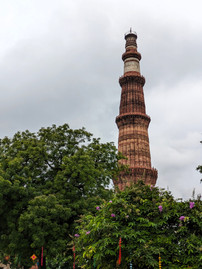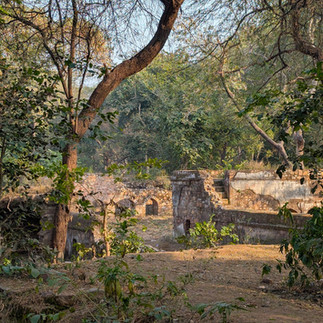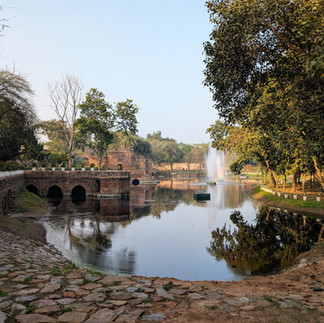The Tailor-Made Guide to Tourist Places to Visit in Delhi – Historical Attractions
- Barry Pickard

- Oct 3
- 15 min read
Updated: Oct 11

Disclosure: This post contains affiliate links. Regardless of this, please be advised that all opinions expressed in this blog post are genuine and authentically my own.
Author: Barry Pickard
Hi, I'm Barry, the owner of Tailor-Made Itineraries and I have been designing bespoke self-guided tours for adventurous and curious travellers since 2015. I am a history graduate with a passion for travel.
I created this blog to show, through my own adventures, how you can have an incredible travel experience as an independent traveller, giving you the information to navigate the world with confidence.
Contents
What are the best tourist places to visit in Delhi that'll transport you through centuries of Indian history in just a few days?
The answer hit me as I stood in the Red Fort's courtyard at dawn, watching the first rays of sunlight catch the intricate marble inlay work while the distant call of street vendors hawking fresh parathas drifted over the ancient walls. Delhi isn't just India's capital—it's a living museum where the scent of incense from 700-year-old Sufi shrines mingles with the diesel fumes of modern auto-rickshaws, and where you can literally walk from a 4th-century iron pillar to a Mughal emperor's tomb in less than ten minutes.

After exploring every corner of this incredible city, I've discovered that Delhi's tourist places to visit aren't just monuments—they're time machines. Each site I'm about to share with you tells a different chapter of India's story, from the legendary Pandavas of the Mahabharata to the British Raj. I've navigated the chaos of crowded dargahs, climbed down into forgotten stepwells, and stood where Gandhi took his final steps, and I'm here to share the insider tips that'll help you experience these places like a local, not just another tourist.

Whether you're planning your first trip to India or you're a seasoned traveller looking to dig deeper into Delhi's layers, this guide will save you time, help you avoid the crowds, and ensure you don't miss the hidden gems that most visitors walk right past. Trust me—after reading this, you'll know exactly which historical attractions deserve your limited time and how to experience them at their absolute best.
Don’t forget that Tailor-Made Itineraries delights in creating bespoke self-guided tours. So, if visiting any of these historical attractions appeals to you, reach out to me by email. I would be more than happy to design a self-guided tour around your requirements incorporating the tourist places to visit in Delhi or indeed, a general tour of India itself.

Tourist Places to Visit in Delhi:
Historical Attractions
Red Fort
The Red Fort, also known as Lal Qila, was built between 1638 and 1648 as the new imperial residence of Shah Jahan. The fort was constructed of red sandstone and marble, and it is decorated with intricate carvings and inscriptions. The fort is surrounded by a moat and has a high wall with 13 gates.

The Red Fort was the centre of Mughal power for over 200 years, being used as a royal residence, a military base, and a government centre. The fort was also the site of many important events in Indian history, such as the coronation of Shah Jahan and the imprisonment of Aurangzeb. Now the fort is one of the must see Delhi attractions.
The Red Fort is a huge complex that contains a number of palaces, halls, and mosques. Some of the most popular attractions at the fort include the Diwan-i-Aam (The Hall of Public Audience), where the emperor would meet with his subjects and foreign dignitaries; the Diwan-i-Khas (The Hall of Private Audience), where the emperor would meet with his ministers and advisors; the Mumtaz Mahal, a palace that was built by Shah Jahan for his wife, Mumtaz Mahal; the Naqqar Khana (The Drum House), where musicians would play music to announce the emperor's arrival and departure; and the Moti Masjid, a white marble mosque that was built by Shah Jahan for the use of his wives and concubines.
Tailor-Made Top Tip:
There are also interesting museums within the fort, such as the Museum On 1857- India's First War of Independence and the Kranti Mandir Netaji Subhas Chandra Bose Museum, so you can easily spend half a day exploring this historic site. There is plenty to see!

Humayun’s Tomb
Humayun's Tomb is a UNESCO World Heritage Site and one of the most iconic landmarks and best places to visit in Delhi. It was one of the first garden-tombs on the Indian subcontinent and is considered to be the precursor to the Taj Mahal.

Humayun's Tomb was built in the 16th century by the Mughal emperor Humayun's first wife and chief consort, Empress Bega Begum. Construction began in 1565 and was completed in 1572. The tomb was designed by Persian architects chosen by her.

Humayun's Tomb is made of red sandstone and white marble and is decorated with intricate carvings and inscriptions. The tomb is a four-story building with a central dome and is surrounded by a beautiful garden with four quadrants.
Tailor-Made Top Tip:
Make sure to visit Isa Khan’s Tomb, which is on your right soon after you enter the complex and before you arrive at the main gateway to Humayun’s Tomb. Isa Khan’s Tomb is much smaller than Humayun’s, but I would argue that it is more appealing.
Hazrat Nizamuddin Dargah complex
The Hazrat Nizamuddin Dargah complex is one of the most revered Sufi sites in India, and is deeply rooted in history, spirituality, and culture. Highlights of the complex includes the Dargah Nizamuddin Aulia, the Dargah Hazrat Amir Khusro, a baoli (stepwell) and a number of other tombs, such as the Barakhamba Tomb Monument. Just to clarify, a dargah is the term used for a shrine built over the grave of a Sufi saint.

Hazrat Nizamuddin Auliya (1238–1325 CE) was a revered Sufi saint of the Chishti Order, known for his teachings of love, compassion, and service to humanity. He welcomed people of all faiths and social backgrounds, emphasizing unity and spiritual devotion. The dargah was built shortly after his death in 1325 and features a white marble dome built in 1562. The dargah is famous for its evening qawwali sessions. These performances continue to draw crowds seeking spiritual solace and musical inspiration.

As for Amir Khusro (1253–1325 CE), he was a legendary poet, musician, and scholar, and a devoted disciple of Nizamuddin Auliya. He is credited with inventing qawwali music, and his tomb lies just outside the main shrine of Nizamuddin Auliya. It is a modest yet deeply revered site.
There are a number of attendants around both dargahs, and for a small donation, they took me into the shrines, provided me with offerings, and demonstrated how to make these offerings. It was a beautiful, but at times, chaotic experience, but well worth doing.
The stepwell, meanwhile, was constructed in 1321–22 CE by Hazrat Nizamuddin Auliya to provide water to the growing number of pilgrims visiting his khanqah (spiritual retreat). The baoli is about 80 feet deep, with a series of steps leading down to the water level.
The Barakhamba Tomb is believed to have been built during the Tughlaq period, possibly under the reign of Muhammad bin Tughluq, in the 14th-century. Its name, Barakhamba, literally means "Twelve Pillars" in Hindi and Urdu, referring to the architectural design of the structure.

Tailor-Made Top Tip:
Just one word of caution, I noted that there were a number of signs around the complex area warning about pickpockets. It’s a good thing to be aware of wherever you are in such a crowded city, but thankfully, I experienced no issues at all.
If you are enjoying this list, remember and subscribe to my mailing list to receive my latest blog posts.
Qutab Minar
The Qutub Minar is a 73-meter-tall minaret and victory tower that stands as a testament to the rich history and culture of Delhi. It is the tallest minaret in the world made of bricks and a UNESCO World Heritage Site. Built between 1199 and 1220 by Qutb-ud-din Aibak, the first Muslim ruler of Delhi, the minaret was originally intended to be a victory tower to commemorate his victory over the last Hindu ruler of Delhi.

The Qutub Minar is a masterpiece of Islamic architecture, with its intricate carvings and inscriptions that tell the story of its construction and the rulers who commissioned it. The minaret is divided into five stories, each with a projecting balcony, and is surrounded by a fluted shaft. The first three stories are made of red sandstone, while the top two stories are made of marble. Access up the minaret is not allowed.
Tailor-Made Top Tip:
Look out for the Iron Pillar of Delhi near the base of the minaret. This 7-meter-tall iron pillar dates back to the 4th century AD and is remarkable for its resistance to rust. The pillar is believed to have been made using a special technique that is now lost.

Mehrauli Archaeological Park
The Mehrauli Archaeological Park is a sprawling heritage site covering over 200 acres, located close to the Qutub Minar complex. It’s one of the richest archaeological zones in India, showcasing over 1,000 years of continuous occupation—from the Rajput era through the Delhi Sultanate, Mughal, and British periods.

There are a number of notable monuments and structures that can be visited within the park, such as the Jamali Kamali Mosque and Tomb, a stunning 16th-century structure known for its intricate red sandstone and marble work; the Rajon Ki Baoli, a beautifully preserved stepwell built during the Lodi period; Balban’s Tomb, the final resting place of Sultan Ghiyas-ud-din Balban (13th century); the Metcalfe Canopy; named after a 19th century, British officer Thomas Metcalfe; and an impressive, unnamed Pathan tomb complex.

Tailor-Made Top Tip:
The Café Stone can be found in the northern corner of the park, and is the ideal place for a light lunch or snack while discovering the archaeological attractions.
Jahaz Mahal
The Jahaz Mahal is a striking historical monument located in Mehrauli, near the Hauz-i-Shamsi reservoir. Its name, which means “Ship Palace” in Urdu, comes from the illusion created by its reflection in the water—making it appear like a ship floating on a lake. Well, unfortunately it is more like a shipwreck nowadays, but still worth checking out, especially if you look to combine it with a trip to the nearby Mehrauli Archaeological Park.

Jahaz Mahal was built between 1451 and 1526, during the Lodi dynasty, and served multiple purposes, including as a pleasure resort or summer retreat for royalty; a Sarai (inn) for pilgrims visiting Delhi’s Sufi shrines.

Tailor-Made Top Tip:
While today the Jahaz Mahal is the venue for the annual Phool Walon Ki Sair (Procession of the Florists), a vibrant festival celebrating Delhi’s composite Hindu-Muslim culture.
If you are enjoying this list, remember and subscribe to my mailing list to receive my latest blog posts.
Gandhi Smriti Museum
The Gandhi Smriti Museum, also known as Birla House, is dedicated to Mahatma Gandhi and was where he spent the last 144 days of his life, before being assassinated on 30 January 1948. The main building, which was originally the house of the Birla family, Indian business tycoons, is now home to the Eternal Gandhi Multimedia Museum. This exhibition tells the story of Mahatma Gandhi's life and work through interactive exhibits, films, and photographs. There are also displays of his personal belongings, such as clothes, books, and glasses. All this makes the museum one of the most poignant of Delhi attractions.
There is a beautiful lawn and gardens that extends beyond the exhibition building, with a small, simple shelter near the bottom, which is where Gandhi’s assassination took place. There is also a highly informative display that runs down the perimeter of the garden.
Tailor-Made Top Tip:
Look for the footprints that lead out along the garden. These were the last steps taken by Gandhi before his tragic death.

Purana Quila
Purana Qila (Old Fort) in Delhi is one of the city's most historically rich and architecturally significant monuments and one of the most captivating Delhi tourist spots. It blends mythology, Mughal grandeur, and ongoing archaeological intrigue. The fort was built by Emperor Humayun in 1533 CE as part of his city Dinpanah, then was later modified by Sher Shah Suri, who overthrew Humayun and added his own architectural touches.

Interestingly, it is believed to be built on the site of Indraprastha, the legendary capital of the Pandavas from the Mahabharata. Excavations have uncovered Painted Grey Ware pottery dating back to 1100–500 BCE, which seems to support this theory.

Highlights of the fort include the Bada Darwaza (Main Gate), with its stunning red sandstone with decorative marble inlays; the Qila-e-Kuhna Mosque, a stunning example of pre-Mughal Indo-Islamic architecture, with intricate calligraphy and geometric patterns; the Sher Mandal, a two-story octagonal tower originally used as a library by Humayun, but where he tragically fell down the stairs and died in 1556; and the Humayun Darwaza, which served as a major entrance during the Mughal period.

Tailor-Made Top Tip:
A Sound and Light Show is held in the evenings, which narrates Delhi’s history with dramatic lighting and audio effects, making the fort one of the ever popular tourist spots in Delhi.
Ugrasen Ki Baoli
Ugrasen ki Baoli is one of the largest and deepest stepwells in India, being 60 meters long, 15 meters wide, and 103 steps deep. The stepwell is believed to have been built in the 14th century, during the Tughlaq or Lodi dynasty of the Delhi Sultanate. The stepwell is named after King Agrasen, a legendary king from the Mahabharata epic.

The stepwell was used to store rainwater and provide water to the people of Delhi during the dry season. It was also a popular place for people to gather and socialize. The stepwell fell into disrepair in the 19th and 20th centuries, but it was restored by the Archaeological Survey of India in the 1980s.
Tailor-Made Top Tip:
Be careful when walking down the steps, as they can be slippery, and there are no railings. There is no lighting inside the stepwell, so it is best to visit during daylight.
National Museum, New Delhi
The National Museum is the largest museum in India housing a vast collection of artifacts that has grown steadily over the years, and now includes over 200,000 objects, dating back to the prehistoric era. The museum was founded in 1949, shortly after India gained independence from the British, with the aim of preserving and showcasing India's rich cultural heritage.

The National Museum's collection is divided into several sections, including: Prehistory and Archaeology, which includes stone tools, pottery, and sculptures; Ancient History, which includes coins, seals, and inscriptions; Medieval History, which includes weapons, armour, and textiles; Modern History, which includes paintings, lithographs, and photographs; Decorative Arts, which includes metalwork, jewellery, and textiles; and Anthropology, which includes artifacts from India's diverse tribal cultures.
Tailor-Made Top Tip:
If you are only going to visit one place in Delhi to see and learn about India’s rich history and culture, then I’d recommend that it was the National Museum.
India Gate
India Gate was built between 1921 and 1931 to commemorate the Indian soldiers who died in World War I and the Third Anglo-Afghan War. India Gate was designed by Edwin Lutyens, the British architect who also designed many of the government buildings in the area. The gate has become one of the most iconic landmarks in New Delhi and is a popular with locals and tourists alike.

The gate is 42 meters high and was heavily influenced by the Arc de Triomphe. There are over 13,000 servicemen’s names engraved on the gate.
Tailor-Made Top Tip:
Access to the complex in the gate stands has been restricted (for security reasons?) and there are now only two main ways to enter – on the west side, there is a pedestrian underpass that leads from the Kartavya Path, and from the east side from the Amar Jawan Jyoti Road.
Safdarjung Tomb
Safdarjung's Tomb is a magnificent Mughal-era tomb, and it was the last major monument built by the Mughals, and it is considered to be one of the finest examples of Mughal architecture. The tomb was built between 1753 and 1754 for Nawab Safdarjung, the Prime Minister of the Mughal Empire. The tomb was designed by the Persian architect Mir Mulla Sayyid.

The tomb is made of red sandstone and white marble, and it is decorated with intricate carvings and calligraphy. The garden is a beautiful charbagh garden, which is a type of Mughal garden that is divided into four quadrants, and you can spend a pleasant half-hour wandering around it.

Tailor-Made Top Tip:
For such a splendid tomb, there were few people there when I visited and must be one of the most under rated of Delhi tourist spots. Subsequently, it seems to be the one place in Delhi where there were no taxis or auto rickshaws hanging about, so take this into consideration when planning how to leave.
Jantar Mantar
Jantar Mantar is an astronomical observatory built in the early 18th century by Maharaja Jai Singh II of Jaipur, who was a keen astronomer and mathematician. The observatory is a collection of 13 architectural astronomy instruments that were used to measure the positions of the stars and planets, predict eclipses, and compile astronomical tables.

The site is considered to be one of the finest examples of astronomical architecture in the world and is also one of the most unusual tourist attractions in Delhi. The instruments at the observatory are large and impressive, and they are still accurate to a high degree today.

The most notable instruments include the Samrat Yantra, which is a large sundial that is used to measure the time of day, the declination of the sun, and other astronomical parameters; the Misra Yantra, which was used to measure the positions of the planets and stars; and the Ram Yantra, which was used to measure the altitude of the sun and to predict eclipses.
Tailor-Made Top Tip:
Jantar Mantar is a short distance from the Gurudwara Sri Bangla Sahib, so it makes sense to combine the two in a visit.
Conclusion
Delhi's historical attractions aren't just tourist sites—they're portals into one of the world's most fascinating civilizations. From the moment you walk through the Red Fort's massive gates to when you stand in the peaceful gardens of Safdarjung's Tomb, you're not just sightseeing; you're experiencing the rise and fall of empires, the birth of new architectural styles, and the convergence of cultures that shaped modern India. Each monument I've shared tells its own story, but together they weave the incredible tapestry of Delhi's 1,000-year journey from ancient Indraprastha to today's bustling metropolis. The best part? You can experience all of this history in just a few action-packed days, armed with the insider tips I've learned through my own adventures navigating this amazing city.
Where to Stay in Delhi
As befits a vibrant capital city, Delhi offers a diverse range of accommodations to suit every traveller's preferences, and there are a number of interesting types of hotels that will serve your trip perfectly when visiting the tourist attractions in Delhi.
Palace & Heritage Hotels: These opulent retreats are housed within historic royal mansions and traditional mansions (known as havelis). Once the abodes of India's rulers, they are a blend of tradition and modernity. Choose the likes of The Imperial New Delhi and the Haveli Dharampura and expect regal architecture, lush gardens, and impeccable service.
Boutique Hotels: Quirky, intimate, and stylish, boutique hotels cater to discerning travelers. Each one has a unique personality, often reflecting the local culture. Choose the likes of The Manor - New Delhi and the Udman Panchshila Park by Ferns N Petals. Expect personalized service and artistic interiors.
Business Hotels: Strategically located near commercial hubs, business hotels cater to corporate travelers. The likes of the Crowne Plaza Okhla and the Radisson Blu Dwarka provide efficient services, well-equipped conference facilities, and comfortable rooms.
Airport Hotels: There is a great selection of hotels around the Indira Gandhi International Airport. Delhi is a massive and congested city, so if you want to see the attractions, there is no particular area where you can easily reach all the main sights. However, the airport arguably has the best connections with the various metropolitan area, so basing yourself in the likes of the Aloft New Delhi Aerocity or the ibis New Delhi Aerocity Hotel is a good idea for Delhi sightseeing.
Related Blog Posts
If you would like more information on the tourist spots in Delhi and how to visit these locations, please view the Tailor-Made Itineraries posts below:
Which of these incredible historical sites are you most excited to visit, or have you discovered any hidden gems in Delhi that I should add to my next trip? Let me know in the comments section below.
Don’t forget that Tailor-Made Itineraries delights in creating bespoke self-guided tours. So, if visiting any of these historical attractions appeals to you, reach out to me by email. I would be more than happy to design a self-guided tour around your requirements incorporating the tourist places to visit in Delhi or indeed, a general tour of India itself.
Tailor-Made Itineraries posts every two weeks, and you can subscribe to the latest blog and newsletter here. Until then, happy reading and safe travels.
Barry
Contact Me: tailoritineraries@gmail.com
Tailor-Made Itineraries creates one-of-a-kind bespoke self-guided travel itineraries for adventurous and curious travellers.
These self-guided tours deliver a personalised and exciting holiday experience that takes the effort out of trip planning.
Delhi Historical Attractions Map





















































































































































































































































































Comments